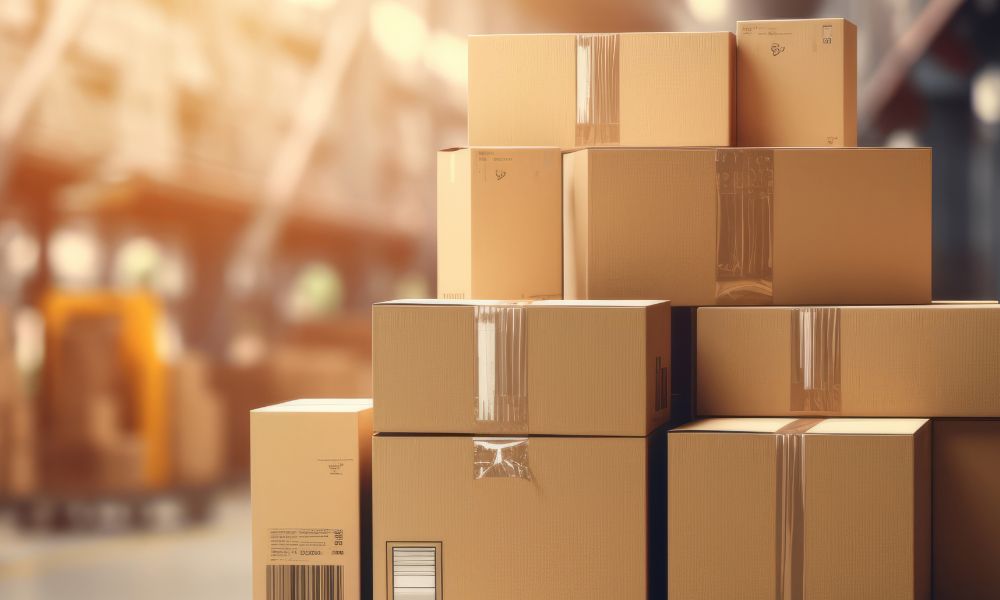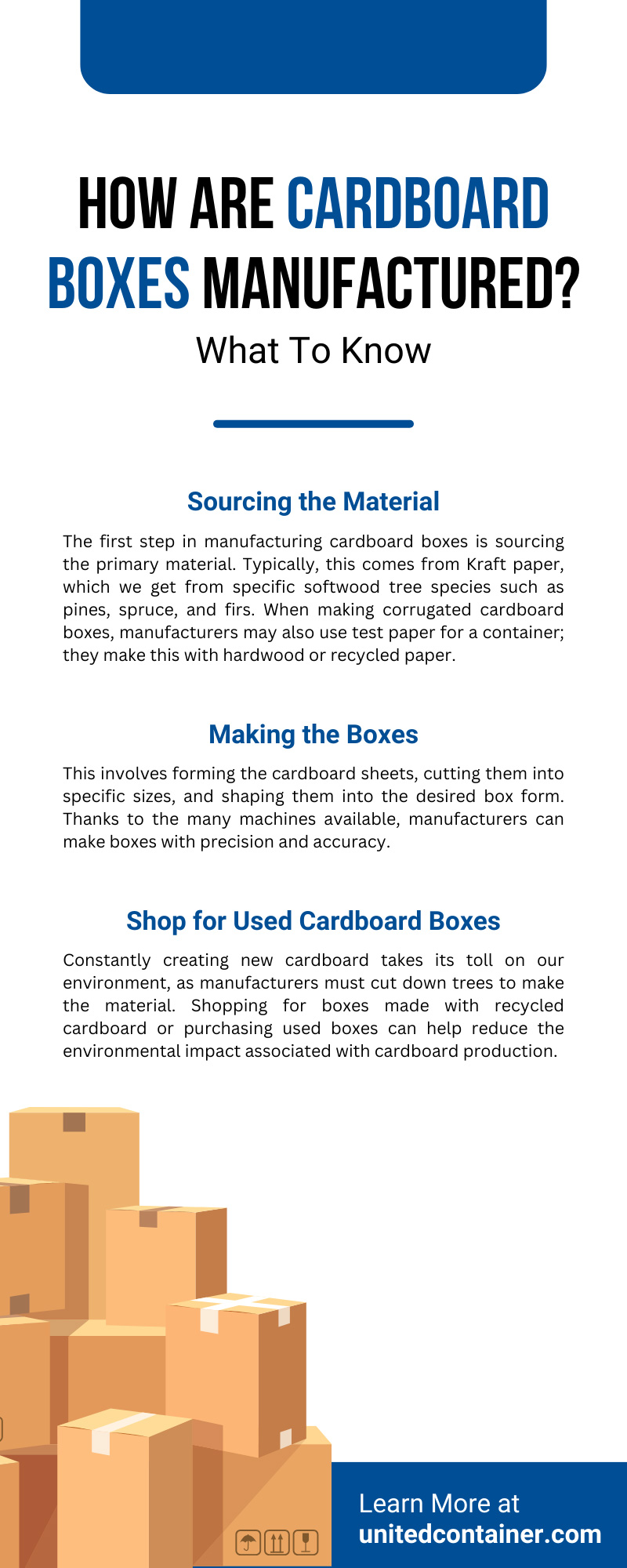
Cardboard boxes are essential to many businesses, especially if those that center around shipping products. They are great for storing goods, protecting items during transport, and adding a personal touch with customized branding. But have you ever wondered how we make these versatile boxes? In this guide, we’ll explain what to know about how cardboard boxes are manufactured.
Types of Cardboard
Before delving into the process of creating cardboard boxes, let’s first discuss the main types of material used. There are two primary types of cardboard used to manufacture boxes: corrugated cardboard and paperboard.
Corrugated Cardboard
Corrugated cardboard has three layers and is comprised of an inner layer called fluting that is sandwiched between two outer layers called liners. This type of cardboard is known for its strength and durability, making it a popular choice for shipping and storing heavy items.Commonly used boxes, such as Gaylords, use corrugated cardboard because of the material’s durability.
Paperboard
Paperboard, also known as chipboard, is a lightweight cardboard made from compressed layers of paper pulp. Brands often use it to package items such as cereal boxes, shoeboxes, and similar products. Typically, this material isn’t ideal for shipping material because it’s thin and less durable than corrugated cardboard.
Sourcing the Material
The first step in manufacturing cardboard boxes is sourcing the primary material. Typically, this comes from Kraft paper, which we get from specific softwood tree species such as pines, spruce, and firs. When making corrugated cardboard boxes, manufacturers may also use test paper for a container; they make this with hardwood or recycled paper.
From Tree to Pulp
Manufacturers must harvest the trees for the wood pulp to make new cardboard. Once the trees have been felled, they go through a process of chipping and grinding to break them down into small pieces. The resulting material is then heated with water and chemicals to create a pulp.
Creating the pulp involves grinding the wood into small chips, which are then carefully cooked under high pressure and temperature in a precisely formulated chemical solution. In doing this, manufacturers break down the wood fibers into a thick and mushy substance known as pulp.
This intricate process effectively breaks down the lignin. This natural adhesive binds the cellulose fibers, resulting in a refined pulp that acts as the foundation for various paper products and materials.
Heating the Pulp
Manufacturers subject the raw pulp to a heating process after obtaining it from the tree. This crucial step serves two primary purposes. First, it eliminates any potential microorganisms presentin the pulp, ensuring the safety and hygiene of the end product.
Heating the pulp also helps break down the lignin, the natural adhesive that binds the cellulose fibers together. Heating the pulp enables the subsequent stages of forming and shaping the cardboard to become more efficient for manufacturers.
Creating the Kraft Paper
Post-heating, the pulp undergoes several processes, including washing, bleaching, and drying. Manufacturers use large reels to roll the Kraft paper. This Kraft paper forms the basis of the cardboard, helping create a sturdy, reliable box.
Using Recycled Cardboard
Rather than using only raw pulp to create cardboard, some manufacturers may blend it with recycled cardboard. This process helps reduce waste and is an eco-friendly alternative to solely using new materials. In this instance, the blend will still undergo the heating process.
Making the Boxes
Once you understand the process of how Kraft paper is created, the next thing to know about how cardboard boxes are made is the creation of the box itself. This involves forming the cardboard sheets, cutting them into specific sizes, and shaping them into the desired box form. Thanks to the many machines available, manufacturers can make boxes with precision and accuracy.
Forming the Cardboard Sheets
Once the Kraft paper is ready, it’s time to transform it into cardboard through a process known as fluting; manufacturers layer sheets of Kraft paper together using a starch-based adhesive. The middle layer, known as the corrugating medium, gets shaped into a series of waves, or flutes, which gives the cardboard its unique combination of strength and flexibility. After this, two flat layers of Kraft paper sandwich the fluted layer, creating a strong, rigid material that’s perfect for constructing boxes.
Adhering the Liners
Next, manufacturers use machinery to apply a layer of adhesive to the inner and outer liners of the corrugated cardboard. Once applied, the liners attach to either side of the fluted medium, creating one solid sheet of corrugated cardboard.
Cutting and Scoring the Cardboard
Large machines cut the cardboard into the desired sizes and shapes for the boxes. Scoring involves making shallow cuts into the cardboard, making it easier to fold without cracking or tearing the material. This process ensures each box will have precise dimensions and a neat, professional appearance.
Folding and Gluing
After cutting and scoring the cardboard, creators fold the material into the shape of a box. High-speed machines glue the seams together using a hot melt adhesive, ensuring a secure and durable bond. The boxes are then checked for quality, ensuring they meet the required standards before shipping them out to the businesses that buy them.
Printing and Finishing Touches
Finally, many box makers print logos, product information, or other branding elements on their boxes. Manufacturers can create a wide range of designs and finishes using high-quality inks and advanced printing techniques. After printing, the boxes may be coated with a protective layer to enhance their durability and resistance to moisture.
Pro Tip
This process may differ for every company; some buy plain boxes while others customize theirs. You can transform a shipping box into marketing material by choosing the latter option.
Shop for Used Cardboard Boxes
Constantly creating new cardboard takes its toll on our environment, as manufacturers must cut down trees to make the material. Shopping for boxes made with recycled cardboard or purchasing used boxes can help reduce the environmental impact associated with cardboard production. Companies that sell wholesale supplies of used cardboard boxes prioritize quality and only sell gently used containers; the boxes won’t look torn and beat up.
As a bonus, buying used boxes helps your company save money on shipping since used boxes are less expensive than new ones.
United Container Co.
If you need to buy cardboard boxes in bulk,United Container Company is your go-to option. We sell new and used corrugated boxes in an array of sizes; we can even customize your containers according to your needs. Buy a wholesale supply of boxes that are affordable and durable.







